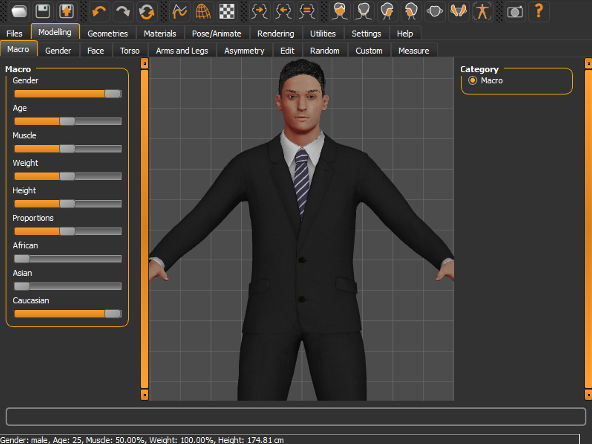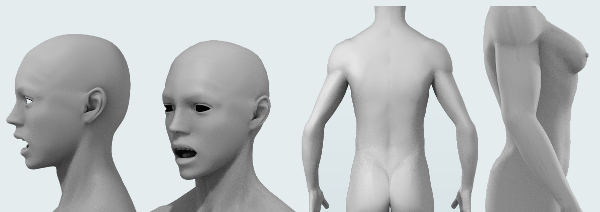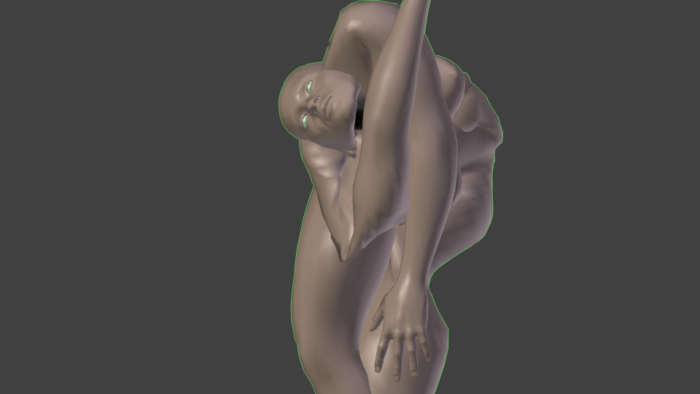The MakeHuman bugreport v0.2
The MakeHuman bugreport v0.2
First part of a second contribution in a series of reports on MakeHuman[1]
MakeHuman is a popular open source 3D computer graphics middleware for the modelling of 3-Dimensional humanoid characters. The software is developed by a community of programmers, modellers and academics. Our interest in MakeHuman was triggered during GenderBlending, an event where a participants from various backgrounds experimented at the contact zones of gender and technology.[2]
A signature feature of the MakeHuman interface is a set of horizontal sliders, suggesting that by interpolating settings for gender, race, weight and age, any 'human' representation can be 'made'. While the neat arrangements of parameters for operating on uncomparable and interconnected properties is already troubling in itself, further inspection reveals an extremely limited topology, rendering the promise of infinite possibillities a mere illusion.
Despite the suggestion that the digital dis-burdens bodies from normative parameters, software like MakeHuman actually operates on problematic categorical divisions that are all-too familiar. This critical reading of the MakeHuman interface is an attempt to get to terms with the various co-conspirators in maintaining that illusion.
Dealing with 3D-humanoid representations
The Homunculus 00 (Enrico Valenza, 2002) 'No male, no female, nor young or old. A perfect neutral body.'[3]
MakeHuman describes itself as a 'free, innovative and professional software for the modelling of 3-Dimensional humanoid characters'[4] and aims to be a startingpoint for prototyping characters that can afterwards be detailed and animated in 3D-animation software such as Blender. 'The ultimate goal is to be able to quickly produce a wide array of realistic virtual humans with only a few clicks of the mouse and be able to render or export them for use in other projects.'[5]
MakeHuman exists somewhere on the intersection between standardized anatomical datasets, amateur animation projects, scientific museum displays and mainstream commercial Hollywood CGI, connecting to an ecosystem of digital body-representations that generally align with gender-stereo-types and neoliberal post-colonialist imagery. The humanoid images it generates are therefore probably as much defined by the conventional projections that each of these worlds radiate, as they are by the technological construction of the tool.
The insistence on producing 'realistic virtual humans' is expressed most clearly in the naming of the project itself. It could have highlighted the joy of working with digital characters, but instead promises a tool for making humans. Even if the high-resolution 3D renderings appear hyper-real, they are generated from a crude underlying structure and based on a simplified understanding of human topologies.The use of 'biologically accurate' parameters suggests that the generated imagery is true to nature, but the principle of 3D mesh topology relies on a trick of averaging, a type of mathematical calculation that has little to do with what our bodies actually looks like.
What is sadly made invisible in the MakeHuman interface and surrounding self-representations is the fact that the resulting images are in fact are being made by a collective of humans and non-humans. Here, algorithms, tools and humans are co-designing and it would be interesting to think what interface could show the effect of this assembly, on the nature of the representation itself.
A meta-bugreport
Skeleton glitch: A character with the MakeHuman gender slider set to the left ('female') animated with a male-typed motion file.
Since discovering MakeHuman a year ago at GenderBlending, we feel the popular, Open Source and long-running project deserves our continued critical attention. In Free, Libre and Open Source software all users have the legal right to run, study, modify, and distribute source code for any purpose. Especially when it comes to matters of representation, it seems important to reserve our energy for tools that invite us to speak back to their social and technological construction. Potentially this establishes a space for interaction and discussion, a possibility for changing and challenging.
We decided to use the format of a 'bugreport' as a frame of reference. A bugreport is a type of formatted feedback used in collaborative software development, where users formulate problems or requests and report those back to a development team. They are a staple element in Free Software development, where teams release often and early, so that their community of users can test. This bugreport is not drawn up by so-called 'power-users' though. We are not experts in 3D-modelling, and only some of us are proficient enough in Python (the programming langage used) to read the MakeHuman code. We are deeply concerned though by the omplicated intersection between gender and technology and troubled by the political and cultural problems that MakeHuman presents.
Our tactic for uncovering bugs could be seen as a kind of collaborative 'investigative journalists of software', using close reading of changelogs and documentation, together with code inspection and artistic experiments to arrive at a form of critique that can deal with the larger assembly of software.[6] The type of 'meta-bugs' we are trying to report here do not fit the templated interfaces of the MakeHuman bugtracker of course, but we need to start somewhere.
- ↑ Bugs included in this report were observed by: Jara Rocha, Femke Snelting, Phil Langley, Rebekka Eisner and Adva Zakai. A first version of this report was delivered at the closing session of GenderBlending (Constant, Brussels, November 2014). A third iteration will be presented as part of Daemons and Shellscripts (MuHKA, Antwerpen, June 2015).
- ↑ In November 2014 Constant invited body hackers, 3D theorists, game activists, queer designers, artists, and software feminists to challenge typical digital representations of the body. Using 3D-animation software, bodyscanners and 3D-printers, participants experimented at the contact zones of gender and technology. http://genderblending.constantvzw.org
- ↑ http://www.makehuman.org/doc/node/professional_mesh_topology.html
- ↑ http://www.makehuman.org
- ↑ http://www.makehuman.org/doc/node/makehuman_and_its_purpose.html
- ↑ Phil Langley in conversation with Femke Snelting, Toronto 2015


